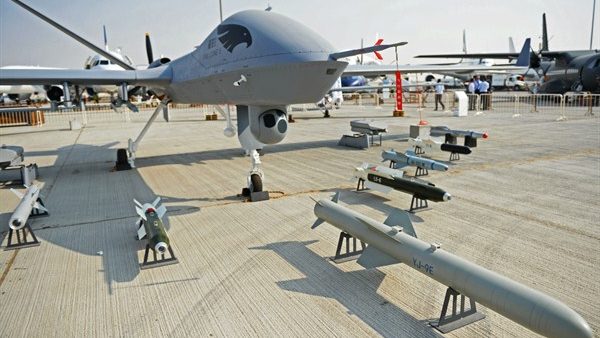Armed drones may not be the killer robots some people fear, but drone weaponry is proliferating faster than international norms governing its use. Find out more when you subscribe to World Politics Review (WPR).
In a move meant to break with his predecessor, President Donald Trump announced new export policies for U.S. armed drones in April. In presenting Trump’s policy shift, Peter Navarro, assistant to the president for trade and manufacturing policy, said it “will level the playing field by enabling U.S. firms to increase their direct sales to authorized allies and partners.” The media reaction was hyperbolic, with one outlet asking whether the policy now meant Trump could “sell deadly drones to dictators,” and another stating in its headline that “Trump offers deadly U.S. drones to more countries.
But does the move simply harken back to the rollout of the Obama administration’s own drone export policy three years ago, with lots of media hype unmatched by actual policy reform? What has really changed, what are the new policy’s objectives, and what will this mean for international security?
The announcement from the State Department on the new policy cited five “primary objectives” for the export of unmanned aerial vehicles. “Increased trade opportunities for U.S. companies” was at the top of the list. The announcement also included strengthening allies’ capacity, improving bilateral relationships, preserving U.S. military advantages, and preventing the proliferation of weapons of mass destruction delivery systems. The United States aims to achieve all that through a policy that loosens the restrictions on the exports of armed drones to its allies.
Can U.S. drone export policy and nonproliferation go hand in hand? To find out, read Separating Fact From Hype in Trump’s New Policy on Drone Exports for FREE with your subscription to World Politics Review.
How China’s Drone Weaponry Could End Up In the Wrong Hands
If the Trump administration is worried about an unlevel playing field, it is due to the increase in drone sales by countries with less-selective criteria for their potential customers, such as China. For the most part, China’s arms industry does not seriously threaten U.S. arms exports, at least not in terms of quantity. That said, there are some areas where China is breaking new ground in the global arms trade, both in terms of new customers and new products. It has sold frigates to Algeria, trainer jets to Bolivia and Venezuela, and anti-ship missiles to Indonesia. More troubling, however, China has quite suddenly become a key exporter of armed drones, also referred to as unmanned combat aerial vehicles, or UCAVs. It’s troubling, not only because it positions China to challenge the U.S. in a potentially lucrative segment of the arms business that is likely to grow significantly over the coming decades. Armed drones are also a growing proliferation concern, given that they are extremely effective and increasingly the weapon of choice on many battlefields.
Armed Drones Make Their Way From the Battlefield to the Streets
Since their emergence as a central part of America’s war on terror, drones have gone from a battlefield innovation to a tool accessible to unsavory groups or characters on the streets. As Homeland Security Secretary Kirstjen Nielsen recently said in a speech outlining the five major areas of concern to her department, until recently a drone “was the hot toy on wish lists. But today, it’s a major national security concern in our homeland.” Does the threat from drones warrant its place on this list? Is it really a concern that should keep Nielsen “up at night,” as she said? The reality is that drones do bring asymmetric advantages to groups with few resources, but they are more likely to be a tool of disruption rather than destruction. And how drones went from being an American counterterrorism tool to a homeland security threat has a longer history than Nielsen suggested.
To learn more about whether armed drones have become a real threat to homeland security, read Are Drones the ‘Perfect Assassination Weapon,’ or an Overblown Threat? for FREE with your subscription to World Politics Review.
Can Killer Robots Be Stopped?
The proliferation of drones has raised alarm over the possibility of completely autonomous systems, or “killer robots,” being deployed in the near future. That in turn has led to a campaign by activists and NGOs to ban such systems. But any success on banning “killer robots” will not be immediate and may require activists to adjust their expectations. Divergent national interests and murky ethical questions make regulating autonomous weapons a difficult proposition. Countries are far from consensus on how and even whether to regulate these fast-emerging technologies. But while killer robots are a far cry from today’s armed drones—and still a long way off—the issue is shaping up to be one of the 21st century’s defining international debates.
To learn more about the push to ban killer robots, and why it might not be a realistic goal, read Can Civil Society Succeed in Its Quest to Ban ‘Killer Robots’? for FREE with your subscription to World Politics Review.
Learn more about armed drones and why killer robots may not be an immediate problem, in the vast, searchable library of World Politics Review (WPR):
- Why the Trump administration’s new policy on exports of armed drones may not be so new after all, in Separating Fact From Hype in Trump’s New Policy on Drone Exports
- Why the U.S. should worry about China’s drone technology and exports, in China Is Suddenly a Leading Exporter of Armed Drones
- How Iran could be copying U.S. drone weaponry, in How Iran Is Deploying Its Drone Program at Home and Abroad
- Whether armed drones represent a real threat to homeland security, in Are Drones the ‘Perfect Assassination Weapon,’ or an Overblown Threat?
- Why it might already be too late to stop killer robots, in Can Civil Society Succeed in its Quest to Ban ‘Killer Robots’?

